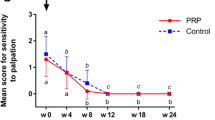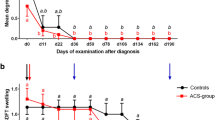Abstract
Local injection of a mixture of beta-aminopropionitril fumarate (BAPN-f) and sodium hyaluronate (NaH+) together with controlled exercise were evaluated for treatment of superficial digital flexor tendon (SDFT) injuries in horses. Fourteen mixed breed horses with subacute SDF tendon injuries in forelimbs were randomly assigned to two groups. One group received BAPN-f (0.7 mg/ml) and the other received NaH+ (10 mg/ml) all by intratendinous injection. Controlled exercise started during the first week after intratendinous treatment and continued for 12 weeks. Cross-sectional area (CSA) of the SDFT, diameter of the SDFT, and relative area of the lesion (presence of CSA) were measured by ultrasonographic examination. Lesions were semiquantitatively graded for echogenicity on a scale of 0 to 4. The lesion severity in CSA was significantly reduced by BAPN and NaH compared to those horses treated by BAPN only (p < 0.05). Lesion echogenicity score was significantly higher in horses treated with BAPN and NaH+ at day 0 compared to horses treated with BAPN (p < 0.05). At the end of the study, lesion echogenicity score was significantly reduced in the horses treated with BAPN and NaH+ compared to horses treated by BAPN only (p < 0.05). According to the results of the present study, a combination of BAPN-f and NaH+ has a greater beneficial effect on tendon healing and remodeling in horses, as assessed by sonographic examination, compared to treatment with single drugs.







Similar content being viewed by others
References
Alves ALG, Rodriguse MAM, Aguir AJA, Borges AS, Nicoletti LM, Thomassian A, Hussni CA (1999) Effects of beta-aminopropionitril fumarat and exercise on tendon healing. J Equine Vet Sci 19(9):560–564
Cherdchutham W, Becker CK, Smith RK, Barneveld A, Van Weeren PR (1999) Age-related changes and effect of exercise on the molecular composition of immature equine superficial digital flexor tendon. Equine Vet J (Suppl) 31:86–94
Cohen IK (1985) Can collagen metabolism be controlled? Theoretical considerations. J Trauma 25:410–412
Cribb AM, Scott JE (1995) Tendon response to tensile stress: an ultrastructural investigation of collagen: proteogylcan in stress tendon. J Anal 187:423–428
Donnelly BP, Nixon AJ, Haupt JL, Dahlgren LA (2006) Nucleotide structure of equine platelet-derived growth factor-A and -B and expression in horses with induced acute tendinitis. Am J Vet Res 67(7):1218–1225 Jul. 2006, erratum in Am J Vet Res 67(9):1627 (Sep)
Dow SM, Wilson A, Goodship AE (1996) Treatment of acute superficial digital flexor tendon injury in horses with polysulphated glycosaminoglycan. Vet Rec 139:413–416
Dowling BA, Dart AJ (2005) Mechanical and functional properties of the equine superficial digital flexor tendon. Vet J 170(2):184–192 (Sep)
Eyre D (1987) Collagen cross-linking amino acids. Methods Enzymol 144:115–139
Foland JW, Trotter GW, Powers BE, Wrigley RH, Smith FH (1992) Effects of hyaluronate in collagenase-induced superficial digital flexor tendonitis in horses. Am J Vet Res 53:2371–2376
Gaughan EM, Gift LJ, Debowes RM, Basaraba R, Roush J (1995) The influence of sequential intratendinous sodium hyaluronate on tendon healing in horses. Vet Comp Orthop Traumatol 8:40–45
Gaughan EM, Nixon AJ, Krook LP (1991) Effects of sodium hyaluronate on tendon healing and adhesion formation in horses. Am J Vet Res 52:764–773
Gerard MP, Hodgson DR, Rose RJ, Walsh WR (2005) Effects of recombinant equine growth hormone on in vitro biomechanical properties of the superficial digital flexor tendon of Standardbred yearlings in training. Vet Surg 34(3):253–259 (May–Jun)
Gibson KT, Burbidge HM, Robertson ID (2005) The effects of polyester (terylene) fibre implants on normal equine superficial digital flexor tendon. N Z Vet J 50(5):186–194 (Oct)
Gift LJ, Gaughan EM, Debowes RM (1992) Effects of intratendinous sodium hyaluronate on enzyme-linked equine tendonitis. Vet Surg 21:389
Goodship AE, Brow PN, Yeates JJ, Jenkins DHR, Silver IA (1980) An assessment of filamentous carbon fibre for the treatment injury in the horse. Vet Rec 106:217–221
Goodship AE (1993) The pathophysiology of flexor tendon injury in the horse. Equine Vet Educ 5:23–29
Harkness MLR, Harkness RD (1959) Effect of enzymes on mechanical properties of tissue nature. Nature 183:1821–1822
Haupt JL, Donnelly BP, Nixon AJ (2006) Effects of platelet-derived growth factor-BB on the metabolic function and morphologic features of equine tendon in explant culture. Am J Vet Res 67(9):1595–1600 (Sep)
Hefti F, Stoll TM (1995) Heilung von ligamenten und sehnen. Orthopäde 24:237–245
Henninger RW, Bramlage LR, Bailey M, Bertone AL, Weisbrode SE (1992) Effect of tendon-splitting on experimentally-induced acute equine tendonitis. Vet Comp Orthop Traumatol 5:1–9
Hosaka Y, Kirisawa R, Ueda H, Yamaguchi M, Takehana K (2005) Differences in tumor necrosis factor (TNF)alpha and TNF receptor-1-mediated intracellular signaling factors in normal, inflamed and scar-formed horse tendons. J Vet Med Sci 67(10):985–991 (Oct)
Howard RD, McIIwraith CM (1996) Hyaluronan and its use in the treatment of equine joint disease. In: McIIwraith CW, Trotter GW (eds) Joint disease in the horse. Saunders, Philadelphia, pp 256–269
Kersh KD, McClure SR, Van Sickle D, Evans RB (2006) The evaluation of extracorporeal shock wave therapy on collagenase induced superficial digital flexor tendonitis. Vet Comp Orthop Traumatol 19(2):99–105
Last JA, Armstrong LG, Reise KM (1990) Minireview: biosynthesis of collagen croolonks. Int J Biochem 22:559–569
Lin YL, Brama PA, Kiers GH, DeGroot J, van Weeren PR (2005a) Functional adaptation through changes in regional biochemical characteristics during maturation of equine superficial digital flexor tendons. Am J Vet Res 66(9):1623–1629 (Sep)
Lin YL, Brama PA, Kiers GH, van Weeren PR, DeGroot J (2005b) Extracellular matrix composition of the equine superficial digital flexor tendon: relationship with age and anatomical site. J Vet Med A Physiol Pathol Clin Med 52(7):333–338 (Sep)
Marr CM, Love L, Boyed JS, McKellar Q (1993) Factors affecting the clinical outcome of injuries to the superficial digital flexor tendon in National Hunt and point-to-point racehorses. Vet Rec 132:476–479
Nimbi ME (ed) (1988) Collagen, vol II, Biochemistry and biomechanics. CRC, Boca Raton, pp 162–175
Pool RR (1992) Pathology of tendons and ligaments. J Equine Vet Sci 12:145–148
Reef VB, Genovese RL, Byrd JW, Reed KP, Davis WM (1996) Treatment of superficial digital flexor tendon injuries with beta-aminopropionitril fumarat (BAPN-f): sonographic evaluation of early tendon healing and remodeling. In: Dubai international equine symposium proceedings, pp 423–530
Robinson RA, Gordon B (1988) American association of equine practitioner track breakdown studies horse results. In: proceedings 7th international conference racing analysis and veterinarian, Kentucky, pp 385–394
Rooney JR, Genovese RL (1981) A survey and analysis of bowed tendon in thoroughbred racehorses. J Equine Vet Sci 1:49–53
Sardari K, Nourozian I (2001) Molecular composition of deep digital flexor tendon after treating the experimental injuries by beta-aminopropionitril fumarat (BAPN-f) in horses. Journal of the Faculty of Veterinary Medicine Tehran University 56(2):35–39
Sardari K, Nourozian I, Movasaghi A, Sorrory S, Van Weeren PR (2000) Experimental study of the healing effects of sodium hyaloronat in deep digital flexor tendon in horses (histopathologic and ultrasonographic findings). Journal of the Faculty of Veterinary Medicine Tehran University 55(2):65–71
Smith RK (2006) Stem cell technology in equine tendon and ligament injuries. Vet Rec 158(4):140 (Jan 28)
Smith RK, Brich H, Patterson-Kane J, Firth EC, Williams L, Cherdchutham W, Van Weeren PR, Goodship AE (1999) Should equine athletes commence training during skeletal development? Changes in tendon matrix with development, ageing, function and exercise. Equine Vet J (Suppl) 30:201–209
Stashak TS (1991) Management of wounds associated with tendons, paratendons, and sheats. In: Stashak TS (ed) Equine wound management. Lea and Febiger, Philadelphia, pp 238–257
Stromberg B (1973) Morphologic, thermographic and 133Xe clearance studies on normal and diseased superficial digital flexor tendons in race horses. Equine Vet J 5:156–161
Tsuzaki M, Yamauchi M, Banes AJ (1993) Tendon collagens: extracellular matrix composition in shear stress and tensile components of flexor tendon. Connect Tissue Res 29:141–152
Watanabe T, Hosaka Y, Yamamoto E, Ueda H, Sugawara K, Takahashi H, Takehana K (2005) Control of the collagen fibril diameter in the equine superficial digital flexor tendon in horses by decorin. J Vet Med Sci 67(9):855–860 (Sep)
Watkins JP, Aure JA, Morgan SJ, Gay S (1985) Healing of surgically created defects in the equine superficial digital flexor tendon: effects of pulsing electromagnetic field therapy on collagen-type transformation and tissue morphologic reorganization. Am J Vet Res 46:2097–2103
Williams IF, McCullagh KG, Goodship AE, Silver IA (1984) Studies on the pathogenesis of equine tendonitis following collagenase injury. Res Vet Sci 36:326–338
Willemen MA, Savelberg HHCM, Barnveld A (1999) The effect of orthopaedic shoeing on the force exerted by the deep digital flexor tendon on the navicular bone in horses. Equine Vet J 31(1):25–30
Acknowledgment
The author would like to thank Mr. Saeed Saedi and Ershad Horse Riding Club for assistance.
Author information
Authors and Affiliations
Corresponding author
Rights and permissions
About this article
Cite this article
Sardari, K. Local injection of a mixture of beta-aminopropionitril fumarate and sodium hyaluronate together with controlled exercise for treatment of subacute superficial digital flexor tendonitis in horses. Comp Clin Pathol 16, 97–102 (2007). https://doi.org/10.1007/s00580-007-0683-1
Received:
Accepted:
Published:
Issue Date:
DOI: https://doi.org/10.1007/s00580-007-0683-1




